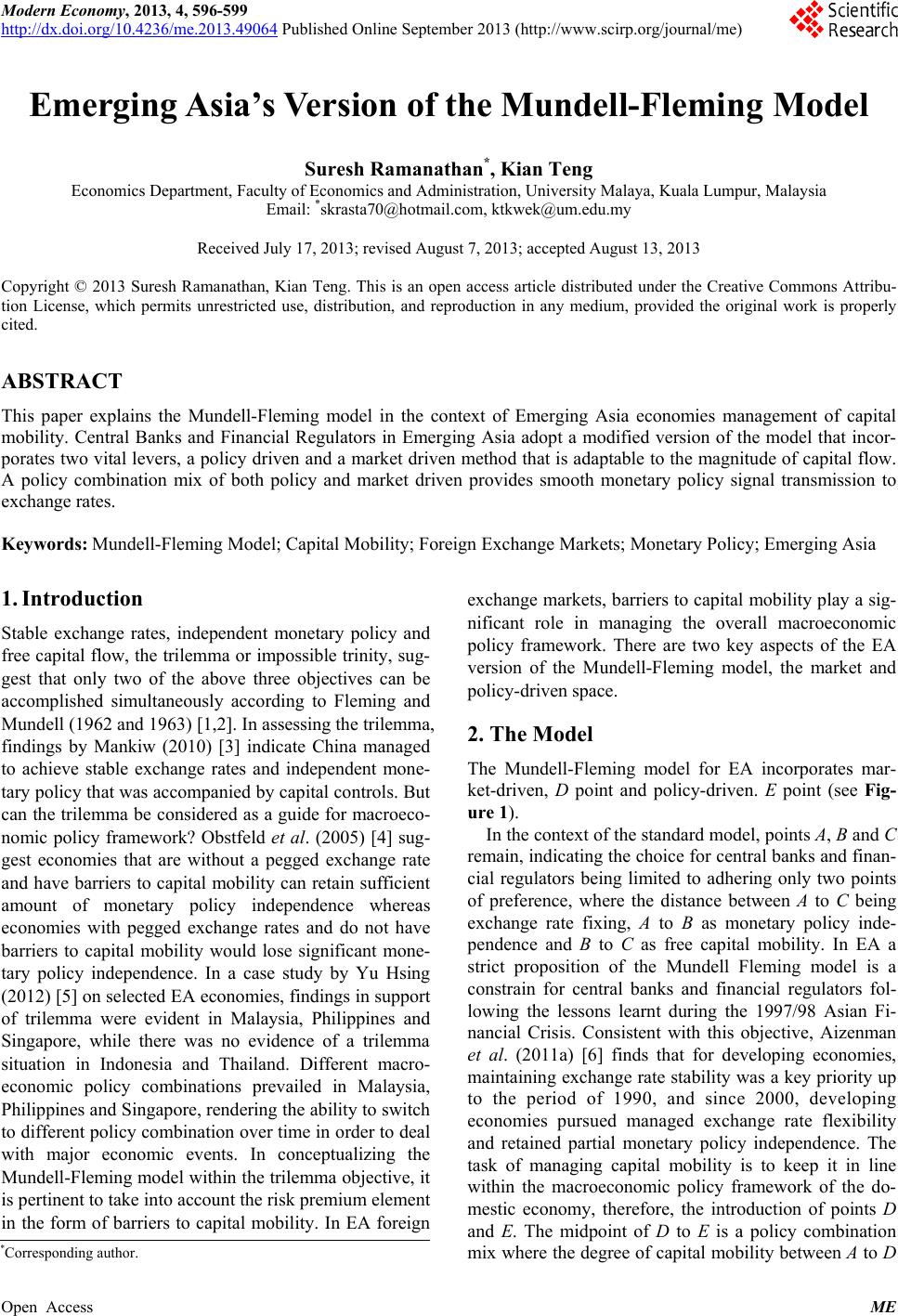
Modern Economy, 2013, 4, 596-599
http://dx.doi.org/10.4236/me.2013.49064 Published Online September 2013 (http://www.scirp.org/journal/me)
Emerging Asia’s Version of the Mundell-Fleming Model
Suresh Ramanathan*, Kian Teng
Economics Department, Faculty of Economics and Administration, University Malaya, Kuala Lumpur, Malaysia
Email: *skrasta70@hotmail.com, ktkwek@um.edu.my
Received July 17, 2013; revised August 7, 2013; accepted August 13, 2013
Copyright © 2013 Suresh Ramanathan, Kian Teng. This is an open access article distributed under the Creative Commons Attribu-
tion License, which permits unrestricted use, distribution, and reproduction in any medium, provided the original work is properly
cited.
ABSTRACT
This paper explains the Mundell-Fleming model in the context of Emerging Asia economies management of capital
mobility. Central Banks and Financial Regulators in Emerging Asia adopt a modified version of the model that incor-
porates two vital levers, a policy driven and a market driven method that is adaptable to the magnitude of capital flow.
A policy combination mix of both policy and market driven provides smooth monetary policy signal transmission to
exchange rates.
Keywords: Mundell-Fleming Model; Capital Mobility; Foreign Exchange Markets; Monetary Policy; Emerging Asia
1. Introduction
Stable exchange rates, independent monetary policy and
free capital flow, the trilemma or impossible trinity, sug-
gest that only two of the above three objectives can be
accomplished simultaneously according to Fleming and
Mundell (1962 and 1963) [1,2]. In assessing the trilemma,
findings by Mankiw (2010) [3] indicate China managed
to achieve stable exchange rates and independent mone-
tary policy that was accompanied by capital controls. But
can the trilemma be considered as a guide for macroeco-
nomic policy framework? Obstfeld et al. (2005) [4] sug-
gest economies that are without a pegged exchange rate
and have barriers to capital mobility can retain sufficient
amount of monetary policy independence whereas
economies with pegged exchange rates and do not have
barriers to capital mobility would lose significant mone-
tary policy independence. In a case study by Yu Hsing
(2012) [5] on selected EA economies, findings in support
of trilemma were evident in Malaysia, Philippines and
Singapore, while there was no evidence of a trilemma
situation in Indonesia and Thailand. Different macro-
economic policy combinations prevailed in Malaysia,
Philippines and Singapore, rendering the ability to switch
to different policy combination over time in order to deal
with major economic events. In conceptualizing the
Mundell-Fleming model within the trilemma objective, it
is pertinent to take into account the risk premium element
in the form of barriers to capital mobility. In EA foreign
exchange markets, barriers to capital mobility play a sig-
nificant role in managing the overall macroeconomic
policy framework. There are two key aspects of the EA
version of the Mundell-Fleming model, the market and
policy-driven space.
2. The Model
The Mundell-Fleming model for EA incorporates mar-
ket-driven, D point and policy-driven. E point (see Fig-
ure 1).
In the context of the standard model, points A, B and C
remain, indicating the choice for central banks and finan-
cial regulators being limited to adhering only two points
of preference, where the distance between A to C being
exchange rate fixing, A to B as monetary policy inde-
pendence and B to C as free capital mobility. In EA a
strict proposition of the Mundell Fleming model is a
constrain for central banks and financial regulators fol-
lowing the lessons learnt during the 1997/98 Asian Fi-
nancial Crisis. Consistent with this objective, Aizenman
et al. (2011a) [6] finds that for developing economies,
maintaining exchange rate stability was a key priority up
to the period of 1990, and since 2000, developing
economies pursued managed exchange rate flexibility
and retained partial monetary policy independence. The
task of managing capital mobility is to keep it in line
within the macroeconomic policy framework of the do-
mestic economy, therefore, the introduction of points D
and E. The midpoint of D to E is a policy combination
mix where the degree of capital mobility between A to D
*Corresponding author.
O
pen Access ME